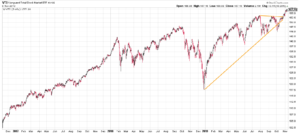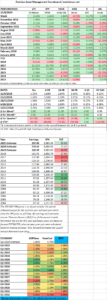HIGHLIGHTS
- US stocks up by 2.42% and international +1.84%.
- Optimism on US-China trade talks.
- Stocks appear to be in good technical shape.
- Bonds fall by 0.72% as interest rates are going up on the longer end of the curve.
- Negative yielding sovereign debt is down to $11.9 trillion from $17 trillion over the summer.
- Imports fell, job openings have declined (but still exceed the number of unemployed), and productivity turned negative.
MARKET RECAP
Equities had a big week around the world as “risk-on” appears to be back in mode, the US advanced by 2.42% and stocks x-US were up 1.84%. There is growing optimism that the US will avoid a recession, helped by supposed progress on a US-China partial trade deal, that will result in a rollback on some tariffs.
We showed a chart similar to the one below at the October webinar and described a “wedge” pattern, and the market has clearly broken out to the upside since then. Time will tell if the market can hold these gains and advance further, but stocks appear to be strong from a technical standpoint.
Bonds fell by 0.72% as interest rates further out on the curve increased. The yield on the 2-year Treasury was up by 12 basis points while the 10-year yield increased by 21 basis points. Interest rates have also been increasing worldwide. There is now an estimated $11.9 trillion in negative-yielding sovereign debt, down from $17 trillion over the summer. The 20-year US treasury has lost about 8% since mid-August.
While optimism is winning the day in the equity markets, the economic statistics are still mixed at best, as shown by some recent reports below.
IMPORTS FALL
Imports for September fell by 1.7% from August according to the Commerce Department. Consumer goods declined by 4.4%, a sharp drop that might indicate that the US consumer is slowing down on spending and/or that tariffs are beginning to impact sales.
JOB OPENINGS DECLINE
There are still plenty of jobs around and the labor market appears strong, but the number of unfilled jobs was a seasonally adjusted 7.02 million at the end of September, according to the Labor Department. That is is the lowest number in 18 months. However, the number of openings still exceeds the number of unemployed by 1.26 million.
PRODUCTIVITY
US worker productivity declined in the third quarter, it was the first quarterly decrease since 2015. However, year over year, productivity was still up by 1.4%. That is in line with the 1.3% average from 2007 to 2018, but lower than the 2.1% annual average since the end of WWII. Economic output is a function of changes in productivity and population growth. With population growth stalling, productivity has to improve for the economy to accelerate its rate of growth.
SCOREBOARD


